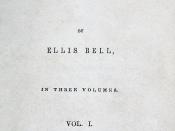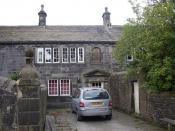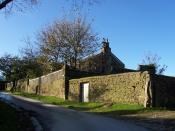Bronte organizes and describes Wuthering Heights by arranging the characters, places and themes in to pairs. Matching and contrasting pairs form the structure through which the book's thematic conflicts play out, as the differences between opposed characters and themes force their way into action and development. Some of the pairs include: the two houses, the two families, and the two Catherines. By pairing these elements, Bronte compares and contrasts the characters to each other, as well as developing them in to intricate characters
The most noticeable pair is that of the two houses, Wuthering Heights and Thrushcross Grange. Wuthering Heights is a house set high upon a hill that is exposed to extreme weather conditions. The Heights is not very pleasing to the eye either. It is described as a harsh, cold house where, "the narrow windows are deeply set in the wall and the corners defended with large jutting stones."
Its inhabitants tend to be rather severe and brutal also. Thrushcross Grange however is altogether opposite from the Heights. Its inhabitants have the appearance of a lifestyle and family that is thought as pleasing. The Grange is first described as a "beautiful, a splendid place carpeted with crimson, and crimson-covered chairs and tables and a pure white ceiling bordered by gold, a shower of glass-drops hanging in silver tapers." Like the house, the Linton's are materialistic and superficial.
This parallelism also extends to the characters. Readers gain insight into these characters not only by observing what they think, say, and do but also by comparing them to their counterparts. Wuthering Heights houses Heathcliff who was adopted in the family, Catherine, and Hindly. Heathcliff is a bitter and vile man who only thinks about revenge and tormenting the lives of others. Catherine points this out by stating "Is Mr. Heathcliff a man? If so, is he mad? And if not, is he a devil?" Catherine plays a major part throughout the book because of the choices she's made. She is a wild girl who ends up marrying Edgar Linton against her better judgment. She later dies because she can not find a way to rectify her true love for Heathcliff. She then haunts Heathcliff for twenty years. Hindley, another child of the Earnshaw family, abuses and torments Heathcliff for being his father's favorite. He continues this childhood hate and brings it in to his adulthood. Thrushcross Grange however is almost completely opposite from the Heights. Its inhabitants have the appearance of a lifestyle and family that is thought of as pleasing. The Grange is first described as a "beautiful, a splendid place carpeted with crimson, and crimson-covered chairs and tables and a pure white ceiling bordered by gold, a shower of glass-drops hanging in silver tapers." Like the house, the Linton's are materialistic and superficial.
Some might say that these characters are mirror images of each other and that they hold many similar traits. This is not the case for mother and daughter, Catherine Earnshaw and Cathy Linton. These two characters are different in many aspects of their lifestyles and personalities. When it comes to their family life, the two Catherines differ greatly. Catherine's father did not show as much love to her because of her constant misbehaving. He stated to her at onetime, "Nay Cathy, I cannot love thee; thou'rt worse than thy brother. Go, say thy prayers, child, and ask God's pardon. I doubt thy mother and I must rue the day we ever reared thee!" Nelly also noted that young Catherine was such a "wild, wicked slip", and that she never seemed as content as when she was being scolded. Being born in to a well off family, Catherine was given the financial reassurance and was conceited all throughout her youth, which contributed to her immaturity. Catherine's personality plays a very vital role in this book. Catherine also throws many tantrums when she doesn't receive what she wishes. One of the first examples of this is "when she learnt the master had lost her whip in attending the stranger, showed her humor by grinning and spitting at the stupid little thing". Catherine's selfish character was illustrated when she wanted both Edgar and Heathcliff at the same time. She wanted Edgar for his money and Heathcliff for his love. She could not choose between the two of them, and therefore she never did. Thus, she caused a lifetime of pain for Heathcliff and Edgar. Catherine also treated her brother Hindley poorly. As a child, she neglected him in favor of Heathcliff. As an adult, Catherine made no effort to help Hindley with his drinking problem after Frances died, nor did she try and prevent Heathcliff from taking advantage of Hindley.
On the other hand, Cathy Linton grows up in a very loving atmosphere at Thrushcross Grange. She is a fine, young lady and blossoms in to a splendid woman. She is extremely close to her father and nurses him at his side when he is ill. Cathy even consents to marry Linton, so she can see her father. Cathy was much more sensible than her mother was. She was able to effectively control her emotions at all times, even during confrontations with her tormentor Heathcliff, and remained strong and grounded throughout the novel. At no point was she abusive, conceited or mischievous. Unlike Catherine, Cathy never receives any siblings, but she wished that she had one. She once said, "Pretty Linton! I wish you were my brother". One can be certain that if Cathy had a brother they would have been very close. Her characteristic traits show that she is a caring and loving woman.
The differences in the emotional and mental state of Catherine and Cathy could be explained by the fact that Cathy did not experience a heartbreaking relationship like Catherine and Heathcliff did. It was this relationship that was the root of all the pain and tragedy in Catherine's life. The mother and her daughter had contrasting views and experiences when it came to love and marriage. Catherine was desperately in love with Heathcliff, and the love they shared was the most powerful force in the novel. However she decides against marrying Heathcliff, and settles with Edgar for a husband. This companionship was not built on true love, but on Catherine's desire to have money.
In comparison, Cathy was forced into marrying Linton, with whom she would have rather had a brother-sister bond. Heathcliff forced this marriage because he wanted the property and assets that she was heir to. Cathy eventually fell in love with Hareton, despite the fact that he was a dirty, illiterate farm laborer. Unlike her mother, Cathy wanted to marry for love, not money or power. This is obvious because of Hareton's financial and social status.
Through the use of pairs, Bronte creates characters that are easy to compare and contrast. Throughout the novel, the houses, its inhabitants and the two Catherines play off each other where similarities and differences can be easily noticed. By pairing these elements, Bronte compares and contrasts the characters to each other, as well as developing them in to intricate characters.








